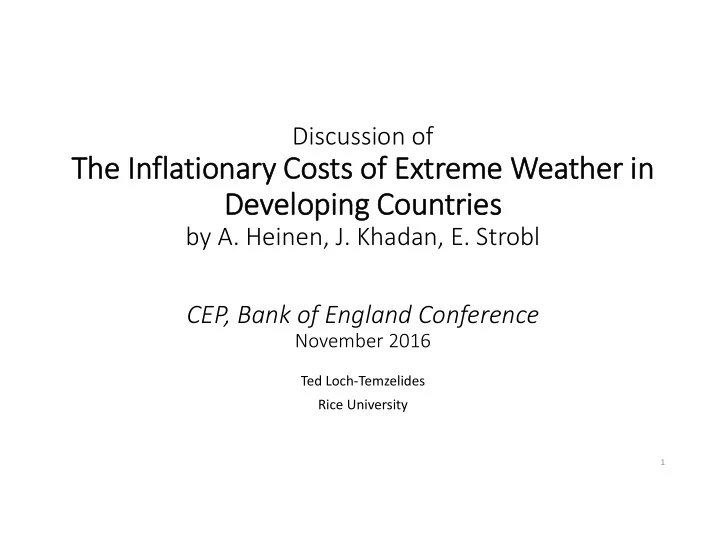

Discussion of The The In Infla flatio ionary ry Cos Costs of of Ex Extr trem eme We Weather in in Dev Developing ping Coun Countri tries by A. Heinen, J. Khadan, E. Strobl CEP, Bank of England Conference November 2016 Ted Loch ‐ Temzelides Rice University 1
Issue Issue • Measurement of climate change related damages (impacts) • Connecting changes in climate variables to economic impacts • Sea level, agriculture, labor productivity, diseases, tourism • Necessary for the assessment of climate change policies • Involves complex interactions between human and natural systems • Weakest link in climate modeling • Two main approaches • Damage functions (aggregate) • Case ‐ by ‐ case damages using local data 2
This This paper paper • Caribbean islands (Jamaica) • Carefully constructed hurricane destruction indexes from • Wind (non ‐ linear in speed) • Flooding (linear in precipitation) • Document extreme weather effect on inflation • Welfare implications • Finding: Expected welfare loses small, but sizable if rare event occurs 3
In Infla flatio ion • Inflation about 4.8% annually over 2001 ‐ 2012 • Rises over hurricanes • Regress inflation rate on contemporaneous hurricane/flood indices • Both have a positive and significant effect on monthly inflation • Evidence of persistence sensitive to hurricane threshold • Is this expected? • Is it a problem? 4
We Welfare Cos Costs • Jamaica • Measure change in households' consumer surplus • Compensating variation: change in expenditure needed to maintain constant utility after change in prices due to hurricane/flood • Hurricanes, floods rare events; not independent • Significant findings • Distributional effects across income groups • Nonlinearities in severity of hurricanes • Threshold sensitivity 5
An An RBC RBC Pe Pers rspective • Extreme weather event like an aggregate productivity shock • Some inflation is what we should expect • Given frequency of such events, inflation an optimal response of the economy to the shock • Given weather shock, less inflation not necessarily better • Hurricane is bad news • GIVEN hurricane, inflation might not be • Policy implications 6
We Welfare Cos Costs ts (ct (ctd.) .) • Welfare costs of inflation usually small • Lucas (10% inflation cost is 1% of GDP) • Cooley and Hansen (10 per cent inflation is 0.4% of GNP) • Imrohoroglu (10 per cent inflation is 1.1% of GDP) 7
Wh What at is is Di Differ eren ent Her Here? 1. “General equilibrium” effects: • Producer surplus • Inflation re ‐ distributional (borrowers/lenders, etc.) 2. It pays off to look closer: • Heterogeneity of population/damages • Developing economy, large fraction at/near poverty • More research needed • Looking at specific episodes to determine mapping from climate to economic damages to welfare is a promising direction • Not yet convinced inflation at the center 8
Recommend
More recommend